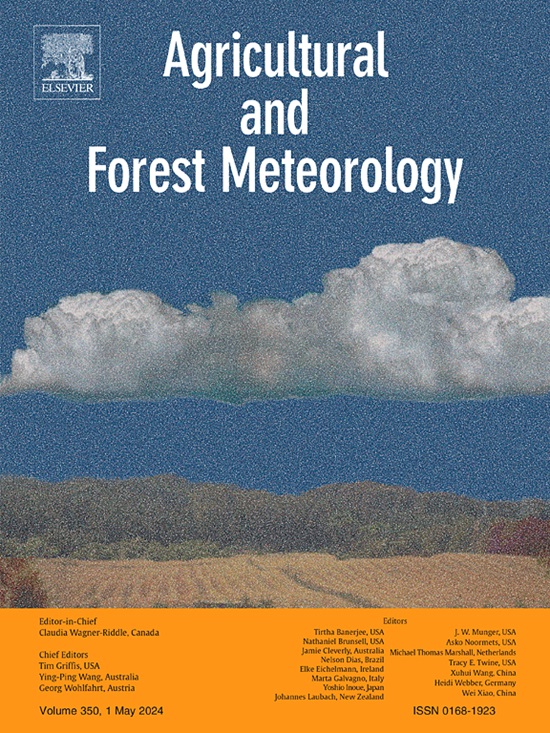Bridging the gap in carbon cycle studies: Meteorological station-based carbon flux dataset as a complement to EC towers
IF 5.6
1区 农林科学
Q1 AGRONOMY
引用次数: 0
Abstract
The scarcity and uneven global distribution of eddy covariance (EC) towers are the key factors that contribute to significant uncertainties in carbon cycle studies of terrestrial ecosystems. To address this limitation of EC towers, Zhang et al. (2023b) developed a meteorological station-based net ecosystem exchange (NEE) dataset. This dataset includes 4674 global meteorological stations, representing a 22-fold increase compared to the 212 existing EC towers and covering a broader range of ecosystem types. Here, we propose a systematic framework for the comprehensive assessment of spatio-temporal representativeness and global uncertainty of the meteorological station-based carbon flux dataset. Meteorological stations effectively enhance the spatial representativeness of the EC towers and reduce the latitudinal variability of the spatial representativeness. In most regions, the temporal trends of carbon flux data from meteorological stations did not significantly differ from those observed by EC towers (p < 0.001). The global uncertainty of carbon fluxes from meteorological station is 0.37, followed by the VISIT and FLUXCOM products with uncertainties of 0.44 and 0.45, respectively. Overall, the carbon fluxes from meteorological stations exhibit higher spatial representativeness and better temporal representativeness compared to the EC tower observations and possess lower global uncertainties than the existing carbon flux gridded products. Consequently, the carbon flux data derived from meteorological stations is a trade-off dataset that addresses the low spatial representativeness of the EC towers and the high uncertainty of the gridded products. It effectively complements the existing EC tower data while ensuring accuracy. The development of this dataset will play an important role in reducing the uncertainty of global carbon sink-related studies.
弥合碳循环研究的差距:气象站碳通量数据集作为EC塔的补充
涡动相关塔的稀缺性和全球分布的不均匀性是陆地生态系统碳循环研究中存在重大不确定性的关键因素。为了解决EC塔的这一局限性,Zhang等人(2023b)开发了一个基于气象站的净生态系统交换(NEE)数据集。该数据集包括4674个全球气象站,与现有的212个EC塔相比增加了22倍,覆盖了更广泛的生态系统类型。在此基础上,提出了一个基于气象站碳通量数据集时空代表性和全球不确定性综合评价的系统框架。气象站有效地增强了欧共体塔的空间代表性,降低了空间代表性的纬度变异。在大多数地区,气象站碳通量数据的时间趋势与EC塔观测的数据没有显著差异(p <;0.001)。气象站碳通量的全球不确定度为0.37,其次是VISIT和FLUXCOM产品,不确定度分别为0.44和0.45。总体而言,与EC塔观测数据相比,气象站碳通量具有更高的空间代表性和更好的时间代表性,与现有碳通量网格化产品相比,具有更低的全球不确定性。因此,来自气象站的碳通量数据是一个权衡数据集,解决了EC塔的低空间代表性和网格化产品的高不确定性。它有效地补充了现有的EC塔数据,同时确保了准确性。该数据集的开发将在减少全球碳汇相关研究的不确定性方面发挥重要作用。
本文章由计算机程序翻译,如有差异,请以英文原文为准。
求助全文
约1分钟内获得全文
求助全文
来源期刊
CiteScore
10.30
自引率
9.70%
发文量
415
审稿时长
69 days
期刊介绍:
Agricultural and Forest Meteorology is an international journal for the publication of original articles and reviews on the inter-relationship between meteorology, agriculture, forestry, and natural ecosystems. Emphasis is on basic and applied scientific research relevant to practical problems in the field of plant and soil sciences, ecology and biogeochemistry as affected by weather as well as climate variability and change. Theoretical models should be tested against experimental data. Articles must appeal to an international audience. Special issues devoted to single topics are also published.
Typical topics include canopy micrometeorology (e.g. canopy radiation transfer, turbulence near the ground, evapotranspiration, energy balance, fluxes of trace gases), micrometeorological instrumentation (e.g., sensors for trace gases, flux measurement instruments, radiation measurement techniques), aerobiology (e.g. the dispersion of pollen, spores, insects and pesticides), biometeorology (e.g. the effect of weather and climate on plant distribution, crop yield, water-use efficiency, and plant phenology), forest-fire/weather interactions, and feedbacks from vegetation to weather and the climate system.

 求助内容:
求助内容: 应助结果提醒方式:
应助结果提醒方式:


